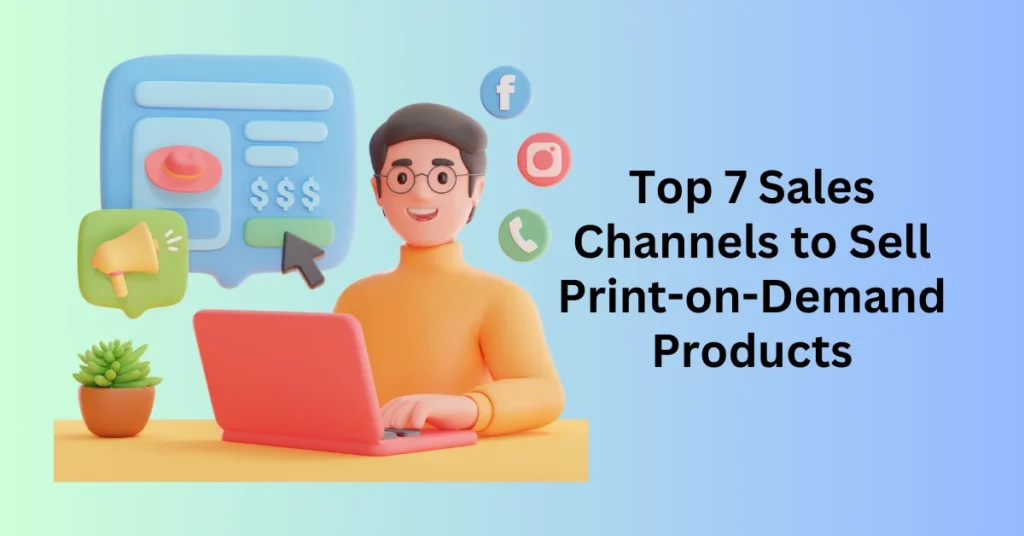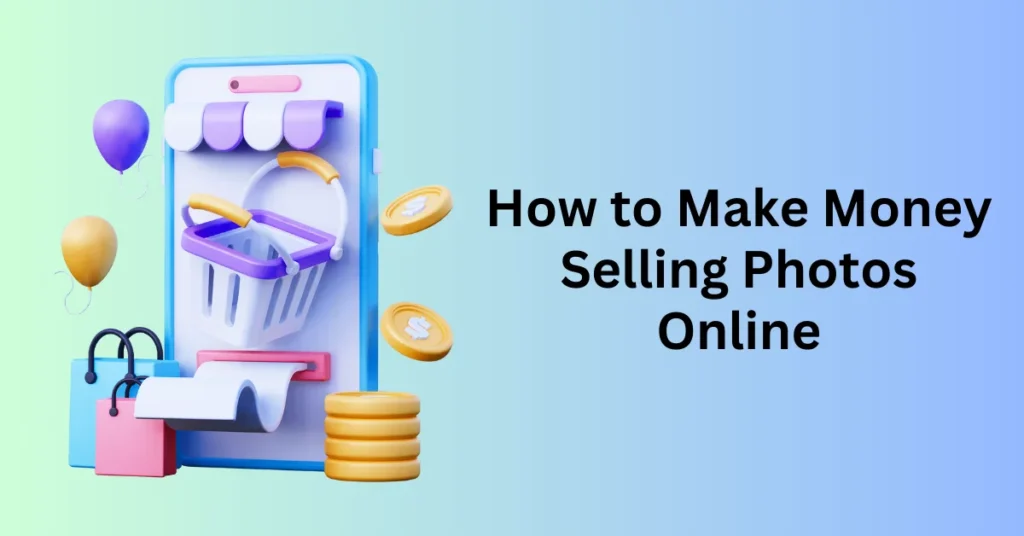If you’ve ever dreamed of becoming an entrepreneur, starting an online print-on-demand business could be your perfect launchpad. Not only does this venture require minimal upfront investment, but it can also be managed from the comfort of your own home. Your primary focus will be on creating unique product designs and handling sales, making it an accessible and appealing option for aspiring business owners. However, choosing the right sales channels is crucial for the success of your print-on-demand business.
Different platforms cater to different products and customer bases. Furthermore, each platform comes with its own fee structures and built-in marketing tools, adding layers of complexity to your decision-making process.
Moreover, the digital age has unlocked countless opportunities to sell custom products online. From platforms that assist you in launching your own online store to ecommerce giants like Amazon, which provide access to a global audience with just a few clicks, the possibilities are vast and varied.
To assist you in navigating these options and finding the best fit for your business, we have thoroughly analyzed the features, benefits, limitations, and pricing of the most popular marketplaces. Therefore, let’s explore the top platforms where you can sell print-on-demand products and set your entrepreneurial journey in motion.
How To Choose The Sales Channels For Your Print-on-Demand Business
Choosing the right sales channel for your print-on-demand (POD) business is crucial to ensuring success and growth. The first step involves understanding your target audience and where they prefer to shop. This requires conducting market research to identify demographic details, shopping behaviours, and preferences of your potential customers. For instance, if your target audience is younger and more tech-savvy, platforms like Etsy or Redbubble, which cater to a more creative and personalized shopping experience, might be more effective. Conversely, if you aim to reach a broader, more diverse audience, marketplaces like Amazon or eBay, which have vast and varied customer bases, could be more suitable.
Another critical factor to consider is the level of competition and the unique value proposition of each platform. Different sales channels have varying levels of competition, and it’s essential to choose one where your products can stand out. For example, while Amazon provides access to a massive audience, it also has fierce competition and strict seller requirements. On the other hand, niche platforms like Society6 or Teespring might have less competition but also a smaller audience. Evaluating the specific features and tools each platform offers can help determine which one aligns best with your business needs. Platforms that offer better marketing tools, integration options, and user-friendly interfaces can significantly impact your ability to attract and retain customers.
Finally, consider the financial implications of each sales channel. This includes understanding the fee structures, commission rates, and any hidden costs associated with listing and selling your products. Platforms like Shopify, while offering great customization and control over your store, come with monthly subscription fees and transaction fees. In contrast, marketplaces like Etsy charge listing fees and take a percentage of each sale, which might be more manageable for startups with limited budgets. Balancing these costs against the potential reach and benefits each platform provides will help you make a more informed decision. Ultimately, choosing the right sales channel involves a combination of understanding your audience, assessing platform-specific factors, and carefully considering the financial aspects to ensure that your POD business can thrive in a competitive marketplace.
Shopify – Print-on-Demand Sales Channels
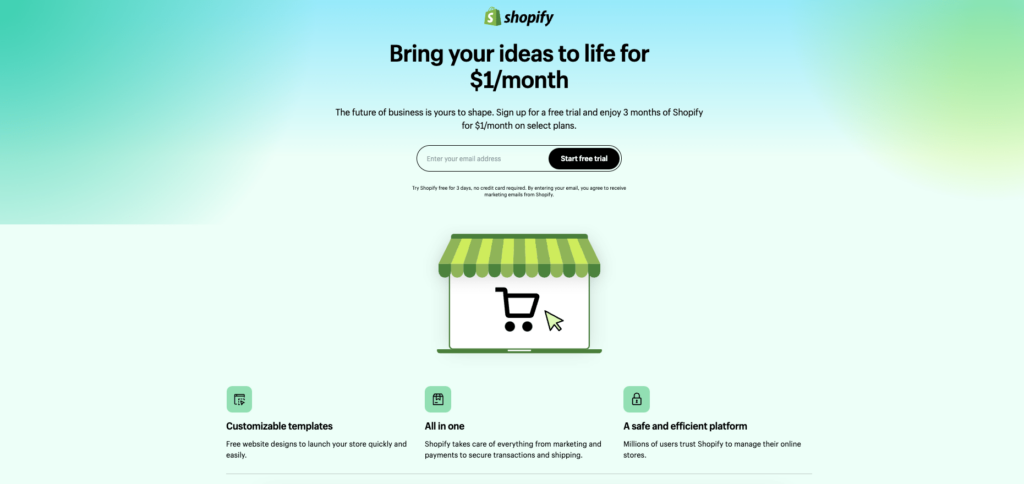
At its core, Shopify is an online store builder that has established itself as a dominant force in the ecommerce industry. As of 2023, Shopify claimed the top spot in the US market with a commanding 28% market share. This impressive influence is also a testament to the company’s commitment to innovation and high-quality customer service.
Besides, Shopify’s user-friendly interface and extensive customization options have been key factors in attracting millions of sellers worldwide. The platform imposes no product restrictions and offers over 400 integrations, including print-on-demand services. These features make Shopify an excellent choice for selling print-on-demand products.
Pros:
- Intuitive Interface and Excellent Customer Service: Shopify provides a fast and easy store setup, supported by helpful customer service.
- Extensive Customization Options: No technical knowledge is required to fully control your branding and design.
- All-in-One Service: Integrations with CRMs, email marketing software, print-on-demand apps, and other major ecommerce platforms.
- Advanced Marketing Analytics: In-depth marketing analytics and sales data reports help you make informed business decisions.
- Built-in Marketing and Sales Tools: Run promotions and ad campaigns directly from the platform.
- Secure Payment System: Simple and secure payments with zero transaction fees when using Shopify Payments.
- Flexible Subscription Plans: Multiple plans to suit different business needs.
Cons:
- Limited Free Trial: The short free trial period doesn’t allow for thorough testing and exploration of the platform.
- Need for Additional Investment: Building organic traffic from scratch requires extra investment to reach your target audience.
- Transaction Fees with Third-Party Payment Providers: Additional fees apply when using payment providers other than Shopify Payments.
- Extra Costs for Add-Ons and Advanced Features: Integrations, domain names, and premium website themes can significantly increase monthly costs.
- Underdeveloped Content Marketing System: The platform’s content marketing tools are limited, which can affect the quality of your blog section and SEO.
Pricing
Shopify offers three primary subscription plans:
- Basic Plan: $25 per month
- Shopify Plan: $65 per month
- Advanced Plan: $399 per month
A 25% discount is available for those who opt for annual billing. Additionally, Shopify offers a Plus option starting at $2,300 per month for more complex businesses with multiple markets and high-volume sales.
New users can benefit from a three-day free trial and a special introductory rate of $1 for the first month.
Etsy – Print-on-Demand Sales Channels
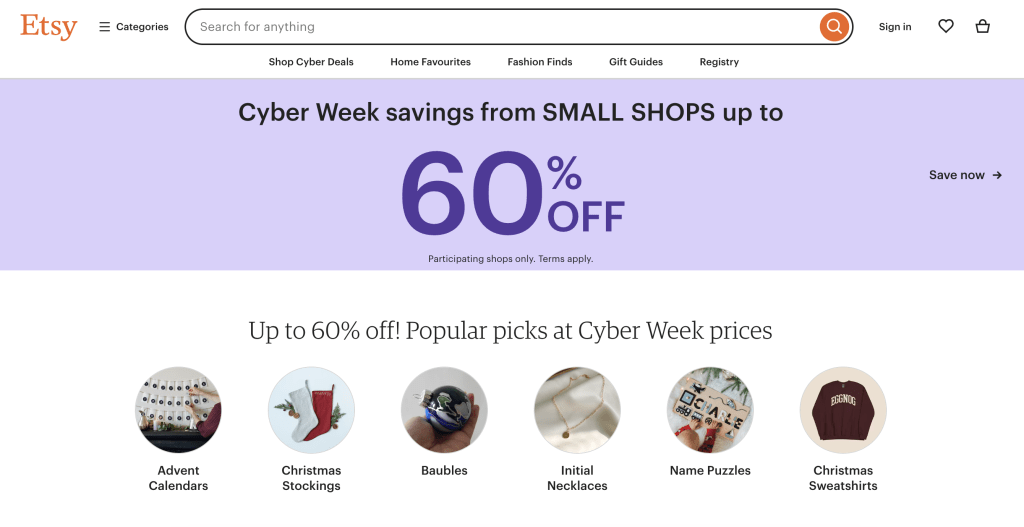
Etsy stands out as the ultimate marketplace for such ventures. With over 96 million active buyers—marking a 1.5% increase from the previous year—Etsy continues to dominate the personalized product sector.
While Etsy remains a niche ecommerce platform compared to giants like Shopify or Amazon, with only 0.13% of the total market share, it offers several significant benefits. These include a specialized customer base, an easy shop setup, and comparatively lower fees, making it an attractive option for sellers.
Pros:
- Low Barrier to Entry: Small starting costs and an easy-to-understand setup make it accessible for new sellers.
- Large Audience for Custom Products: Immediate access to a dedicated audience interested in personalized items.
- Built-in Marketing Tools: Features such as ads, discounts, free shipping campaigns, and off-site integrations help broaden your reach.
- Extensive Learning Resources: The Etsy Seller Handbook provides a wealth of knowledge for optimizing your shop.
- Optimization Tools: Numerous free or paid tools are available to enhance your listings, improve rankings, and boost sales.
Cons:
- High Competition: Increasing competition in major product categories requires more effort and resources to stand out.
- Limited Branding Control: Sellers have little control over the platform’s look and functionality.
- Presence of Non-Handmade Items: The influx of non-handmade and factory-produced items can drive prices down, making it harder for small businesses to succeed.
Pricing
Unlike subscription-based models, Etsy charges fees based on seller activities. Key fees include:
- Listing Fee: $0.20 per published item.
- Transaction Fee: 6.5% of the item’s price for each sale.
- Payment Processing Fees: Vary depending on the gross order amount processed through Etsy Payments.
For those looking to enhance their selling experience, Etsy offers an Etsy Plus membership at $10 per month, which unlocks additional marketing and sales tools.
Etsy is a prime choice for sellers focused on original print-on-demand and custom products, providing an easy entry point and access to a niche market. Despite some challenges, such as high competition and limited branding control, the platform’s specialized audience and supportive resources make it a valuable option for growing your ecommerce business.
Amazon – Print-on-Demand Sales Channels

The list of the best sites to sell print-on-demand products wouldn’t be complete without mentioning the biggest name in ecommerce—Amazon. With over $550 billion in sales and delivery to more than 100 countries and regions, Amazon is a top seller in the US.
Contrary to the perception that Amazon primarily serves big companies, about 60% of sales come from small and medium businesses, making it an attractive solution for selling print-on-demand products. In addition, Amazon has even launched its own print-on-demand platform, Merch on Demand.
Pros:
- Extensive Customer Base: Access to the largest customer base, with buyers in over 180 countries and high daily organic traffic.
- Fulfillment by Amazon (FBA): This option allows you to offer Prime shipping and offload inventory management to Amazon. Alternatively, you can use Printify for dropshipping print-on-demand products.
- Built-in Advertising Tools: Numerous advertising tools help increase reach and build brand recognition.
- High Authority and Reliability: Amazon’s reputation and reliability make buyers trust third-party sellers, including new print-on-demand brands.
Cons:
- High Competition: With 1.9 million active sellers, there’s significant competition, leading to pricing pressure and the risk of idea theft.
- High Commissions and Fees: Amazon’s fees and commissions reduce profit margins.
- Delayed Payments: Amazon pays third-party sellers 90 days after a purchase, which can affect cash flow.
- Limited Branding Control: Amazon’s strict customer service and review standards limit control over store branding and functionality, with the risk of store shutdowns for non-compliance.
Pricing
Amazon offers two selling plans:
- Individual Plan: $0.99 per item sold
- Professional Plan: $39.99 per month
To integrate your Amazon store with a print-on-demand service like Printify, a Professional plan is required. Additionally, Amazon charges referral fees starting at 8%, depending on the product category. In the case of refunds, sellers must pay a refund administration fee ($5.00 or 20% of the respective referral fee, whichever is less).
Amazon is a powerhouse platform for selling print-on-demand products, offering unparalleled access to a vast customer base and powerful fulfillment and advertising tools. However, sellers must navigate high competition, fees, and strict standards, which can impact profit margins and operational control. Despite these challenges, Amazon remains a compelling choice for expanding your print-on-demand business.
TikTok Shop – Print-on-Demand Sales Channels
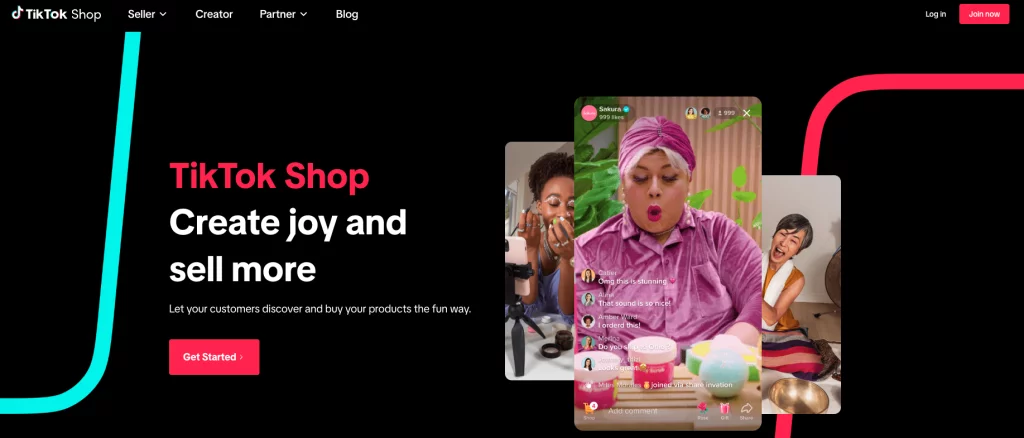
Among the fastest-growing social media apps, TikTok has emerged as a top platform for selling print-on-demand items. Since launching its ecommerce solution, TikTok Shop, in the US in 2023, it has quickly attracted over 31,000 buyers.
The success of a print-on-demand store on TikTok heavily depends on the seller’s activity on the app and the chosen product categories—beauty products and clothing tend to perform best. Additionally, marketing efforts should primarily target TikTok’s main audience, Gen Z.
Pros:
- Affordable Platform: Free registration with a couple of low seller fees.
- Easy Integration: Quick integration within the TikTok app and with other ecommerce platforms like Shopify, WooCommerce, and Amazon to boost sales.
- Built-in Advertising Tools: Utilize discounts, coupons, and free shipping promotions, along with AI-powered algorithms for a tailored user experience.
- Large Pool of Engaged Consumers: Access to a highly engaged Gen Z audience increases the potential for viral reach.
- Advanced Analytics: Data-driven insights provide valuable information about customer preferences.
- Seamless User Experience: Users can transition smoothly from watching content to browsing the online store, encouraging impulse purchases.
Cons:
- Gen Z Focus: The platform is dominated by Gen Z, so products and content need to be tailored to this demographic.
- Video-Only Platform: Requires continuous monitoring of trends and expertise in video filming and editing or the hiring of an expert to produce high-quality content.
- New Ecommerce Feature: TikTok Shop is a recent addition and may undergo multiple iterations.
- Restricted Products: TikTok has a list of restricted products requiring additional approval, potentially delaying new item launches.
Pricing
TikTok charges two main fees:
- Marketplace Commission Fee: 0–4% of the final order value, depending on the product sub-category.
- Transaction Fee: 2.16%, deducted after a successful order delivery.
Additionally, there are several fees related to shipping costs and refunds, calculated on a case-by-case basis.
TikTok offers a promising platform for selling print-on-demand items, especially for targeting the Gen Z demographic. With affordable fees, seamless integration, and robust advertising tools, it presents a valuable opportunity for sellers. However, the platform’s video-centric nature and its focus on a younger audience require sellers to stay on top of trends and produce engaging content consistently. Despite its newness and evolving features, TikTok Shop holds significant potential for print-on-demand businesses.
WooCommerce – Print-on-Demand Sales Channels
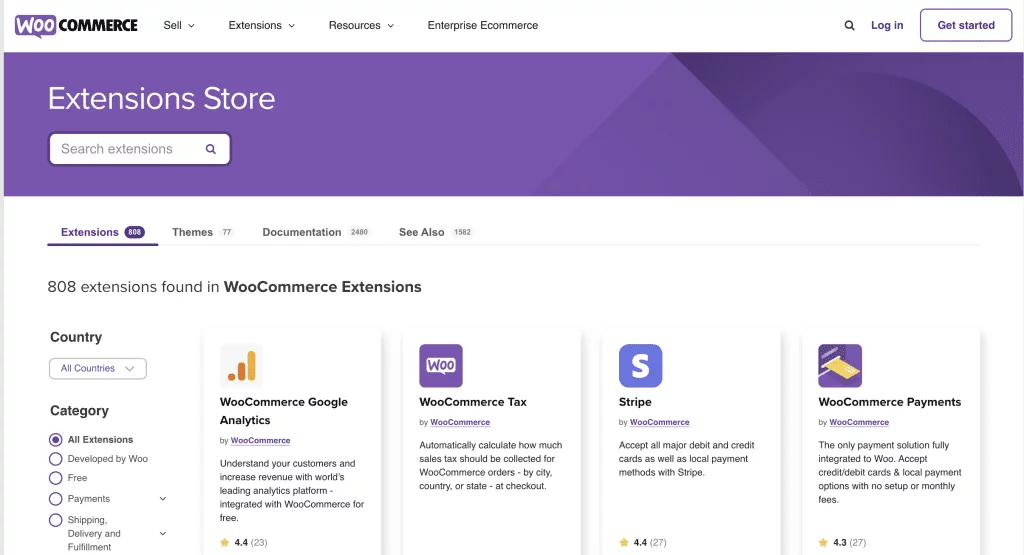
WooCommerce, though less recognizable by name compared to its parent software, is a powerful ecommerce plugin for WordPress, one of the most popular website builders. Recently, WooCommerce has given up its first position to Shopify, yet it still maintains a significant market share with over 23%.
With unmatched customization options and advanced integrations with print-on-demand sites, WooCommerce is a viable solution for print-on-demand businesses. Moreover, it’s user-friendly, requiring no high-level coding skills or additional fees to get started.
Pros:
- Free to Download: Anyone can install WooCommerce to their WordPress website without any additional cost.
- Quick Setup: Besides, ready-made website templates and simple installation process.
- Customization: In addition, you can access to numerous themes, plugins, add-ons, and the ability to input HTML code allows for full branding control.
- Easy Integration: Seamless integration with print-on-demand sites like Printify and other marketplaces like Etsy.
- Community Support: A wealth of guides and blogs from community members in Facebook groups and forums to assist with understanding the platform and resolving issues.
- Secure Platform: One of the most secure ecommerce platforms, offering encryption and two-step authentication.
Cons:
- Potential High Costs: The free version can become expensive as more advanced functions require paid plugins, and hosting costs must be considered.
- WordPress-Exclusive: Only works with WordPress, limiting options for those who have built their websites elsewhere.
- Learning Curve: Requires some expertise in WordPress to manage effectively, posing challenges for novice website builders.
- Audience Building: Without an existing customer pool, you’ll need to build your audience from scratch and invest heavily in marketing.
Pricing
While WooCommerce is free to download, there are several costs to consider:
- Domain Registration: Approximately $15 annually.
- Hosting: Around $150 annually, depending on storage size.
- Shipping Extensions: Up to $119 annually for more advanced options.
- Payment Gateway Costs: Typically 2.9% + $0.30 per sale.
Additional costs are associated with customization and functionality:
- Premium Themes: Can cost over $100 annually.
- Live Chat Function: $49 annually.
WooCommerce is a robust and flexible solution for print-on-demand ecommerce, offering extensive customization and integration options. While it requires some WordPress expertise and can incur additional costs for advanced features, its strong community support and secure platform make it a compelling choice for those looking to build a highly personalized online store.
Wix Stores – Print-on-Demand Sales Channels
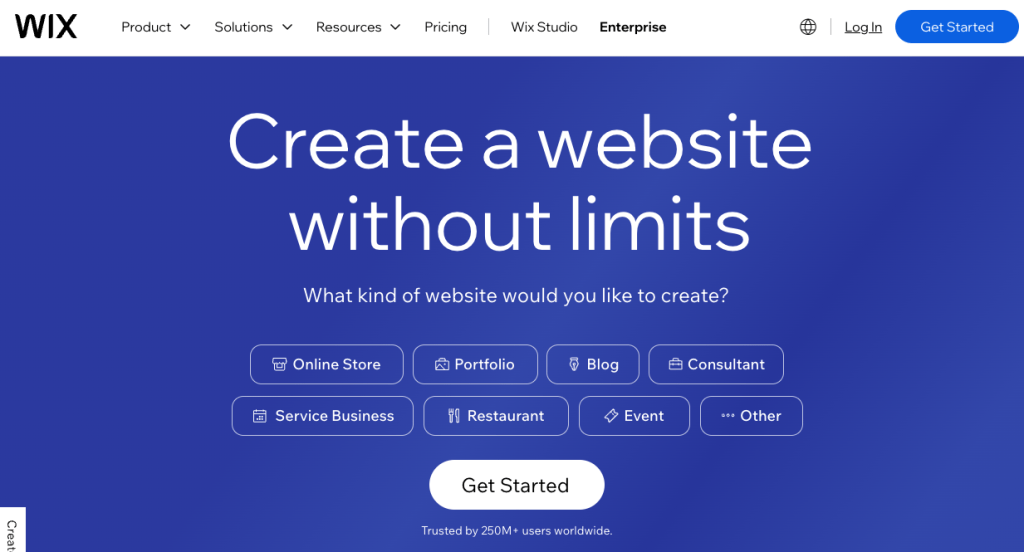
Known as one of the pioneers in drag-and-drop website building, Wix has grown to become the most popular website builder with over 8 billion live sites. Initially designed to help less tech-savvy individuals create their own websites, Wix has evolved into an all-in-one ecommerce solution through Wix Stores.
Besides, recognizing the potential of the print-on-demand business early on, Wix offers seamless integration with various dropshipping and print-on-demand service apps. Its affordability and user-friendly interface make it an appealing option for aspiring entrepreneurs venturing into the print-on-demand market.
Pros:
- Beginner-Friendly Interface: AI design tools allow for quick setup of an online store, making it accessible to beginners.
- Built-In Marketing Tools: Features like SEO Wiz, site chat, and email marketing enhance reach and lead capture.
- Mobile Management: The Wix Owner app enables running your print-on-demand store from a phone.
- Custom Domain: Unlike other platforms, Wix includes a custom domain with all its plans.
- Multilingual Support: Wix is multilingual, allowing you to create multiple versions of your store in different languages to localize your offerings.
Cons:
- Platform Dependency: Wix Stores is accessible only if you build your website on Wix and use one of the paid plans, as the free version doesn’t support custom domains or ecommerce functions.
- Template Limitations: While Wix offers many high-quality templates for different product categories, they aren’t fully customizable, and switching templates requires rebuilding the entire website.
- Limited Add-Ons and Integrations: With over 870 apps on the Wix App Market, it still lags behind platforms like Shopify in terms of available add-ons and integrations for more functional ecommerce stores.
Pricing
Wix Stores offers four main plans:
- Light: $17 monthly
- Core: $29 monthly
- Business: $36 monthly
- Business Elite: $159 monthly
These rates apply to annual subscriptions, with higher rates for monthly plans. Additionally, there is a transaction fee of 2.9% of the transaction amount plus $0.30 for all transactions processed through Wix Payments.
In addition, Wix stands out as a user-friendly, affordable solution for building and managing a print-on-demand store. With its intuitive drag-and-drop interface, comprehensive marketing tools, and multilingual support, it also caters well to beginners and those looking to localize their business. However, the platform’s dependency on paid plans, limited template customization, and fewer add-ons compared to competitors like Shopify are notable drawbacks. Despite these limitations, Wix remains a strong contender for entrepreneurs seeking an accessible and versatile ecommerce platform.
Squarespace – Print-on-Demand Sales Channels
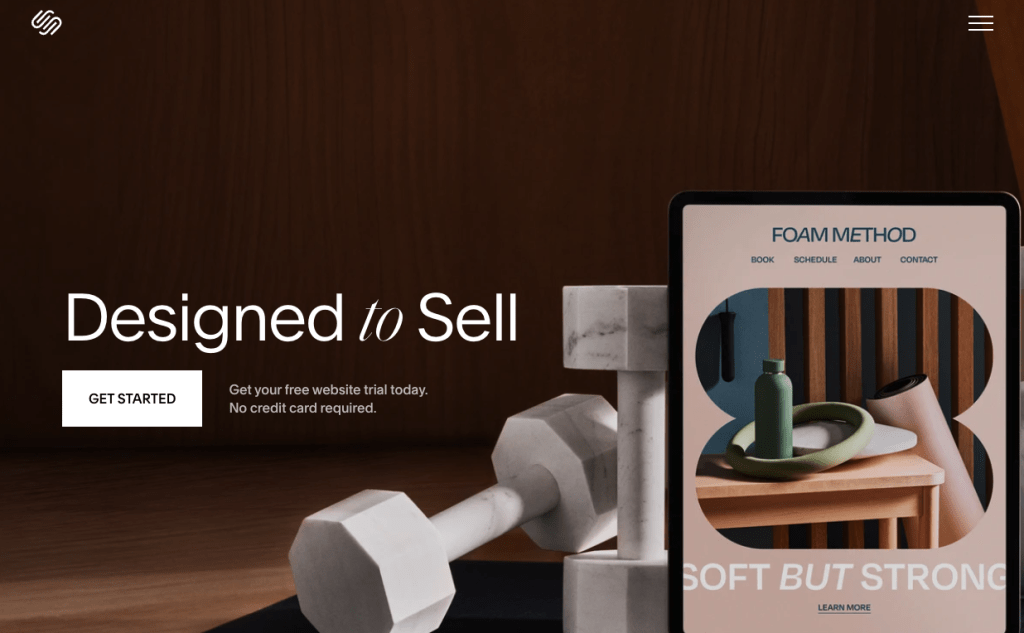
Viewed as the younger sibling of Wix and WordPress, Squarespace has become a notable contender in the ecommerce space, particularly for selling print-on-demand items. Known for its drag-and-drop website builder, Squarespace has significantly improved its ecommerce capabilities over the past decade, achieving a market share of over 10%.
The platform’s appeal to print-on-demand sellers is largely due to its high-quality aesthetic templates and seamless integrations with print-on-demand services. Additionally, Squarespace offers a supportive community and advanced ecommerce features, making it a compelling option.
Pros:
- Intuitive Interface: Squarespace offers a beginner-friendly interface that can be explored with a 14-day free trial, plus student discounts for purchases.
- Advanced Editing and Subscription Options: Provides advanced store editing options and easy-to-implement subscription models for recurring payments.
- Built-in SEO Features: Every plan includes SEO tools to enhance site visibility and boost organic traffic.
- Mobile Optimization: All websites are automatically mobile-optimized, eliminating the need to manually adjust images and text for responsiveness.
- Educational Resources: A vast collection of resources, including online courses, help users master the platform and utilize all features effectively.
Cons:
- Domain Name Costs: Hosting is included in the plan, but users must pay separately for the domain name.
- Limited Website Structure: Supports only simple, two-level website structures, which can be restrictive for larger stores.
- Paid Add-Ons Required: Connecting the Squarespace store to other platforms like Amazon or social media requires paid add-ons.
- Higher Costs: Comparatively more expensive plans can lead to lower profit margins.
- Limited Payment Gateways: Fewer payment gateway options complicate payment processing.
Pricing
Squarespace offers four main plans:
- Personal: $16 monthly (no product sales)
- Business: $23 monthly
- Commerce Basic: $28 monthly
- Commerce Advanced: $52 monthly
Prices increase if opting for a monthly contract instead of an annual one. The Business plan incurs a 3% transaction fee, while all transactions processed through Squarespace Payments carry a fee of 2.9% + $0.30.
Squarespace stands out for its premium aesthetic templates and seamless integrations, making it an attractive option for print-on-demand sellers who prioritize design and user experience. Its intuitive interface, built-in SEO features, and automatic mobile optimization make it a user-friendly choice. However, the platform’s higher costs, limited website structure, and need for paid add-ons may pose challenges for larger businesses and those looking to maximize profit margins. Despite these drawbacks, Squarespace remains a strong contender for entrepreneurs seeking a sophisticated and supportive ecommerce platform.
Final Thoughts: Top 7 Sales Channels to Sell Print-on-Demand Products
The current ecommerce landscape offers a wealth of opportunities to create the print-on-demand store of your dreams and sell your unique designs. Whether you want to sell custom t-shirts, mugs, or posters, there is a platform tailored to your needs.
Firstly to get started, review this comprehensive list of platforms to find the best one for showcasing your products and reaching your target market. It’s important to note that no single solution will suit everyone, as each platform has its own strengths and weaknesses. Therefore, consider the option of combining several platforms to expand your reach and maximize your sales potential.
Partnering with a dropshipping and printing service like Printify can significantly streamline your operations. With Printify handling the production and fulfillment, you can then focus entirely on creating trendy, appealing products and marketing them effectively. This also allows you to leverage your creativity and business acumen without getting bogged down by logistical challenges.
By carefully selecting the right platforms and partners, you can set up a thriving print-on-demand store that showcases your designs to a global audience. Take advantage of the myriad tools and resources available to make your entrepreneurial vision a reality.
